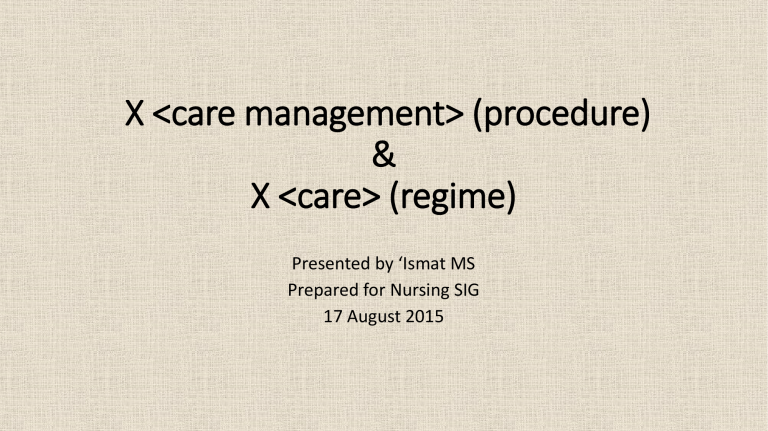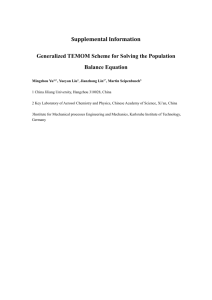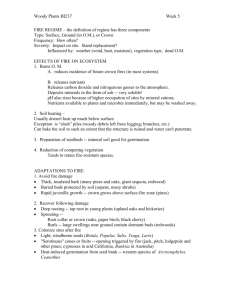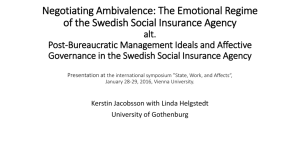(regime) - IHTSDO Confluence

X <care management> (procedure)
&
X <care> (regime)
Presented by ‘Ismat MS
Prepared for Nursing SIG
17 August 2015
The issues:
X care (regime/therapy) from |Care regime|
X care management (procedure) from |Care regime management|
1. What is |Care regime|?
a. Is it just a grouper concept?
2. What is |Care regime management| procedures?
a. Is it just care planning, or more?
3. How to differentiate the two concepts?
Current definition (1)
The Editorial Guideline define the concepts under (regime/therapy) as:
• Aggregates of sub-procedures; AND repeated multiple times, over the space of an extended period of time; OR
• Aggregates of sub-procedures; AND are focused on a single purpose but do not have any single sub-procedures as a necessary part.
There is no definition in the guidelines to define “Care regime” in |Care regime (regime/therapy)| and what should its subtypes be.
There is also no guideline to differentiate |Care regime (regime/therapy)| concepts with |Care regimes management (procedure)|.
Current definition (2)
The meaning was discussed during CTP cohort group discussion and meeting with Vice Chair of Nursing SIG:
• |Care regime (regime/therapy)| or [X <care>] is a regime to manage patients’ health through direct patient contact ;
• |Care regime management (procedure)| or [X <care management>] is the act for managing care regimes, reserved mainly for administrative purposes and/or do not need direct patient contact.
However, this definition is still vague and cannot be applied to the current hierarchy. The application to actual setting is also questionable.
Issue 1:
What is |Care regime (regime/therapy)|
If we use the same definition for current |Care regime (regime/therapy)| hierarchy and compare with other sibling concepts, we will find that this definition is insufficient to differentiate it from some of the other concepts.
Adjunctive care (regime/therapy)
Advocacy (regime/therapy)
Anesthesia management (regime/therapy)
Biological treatment (regime/therapy)
Care regime (regime/therapy)
Child health procedures (regime/therapy)
Clinical observation regime (regime/therapy)
Deafness remedial therapy (regime/therapy)
Desensitization therapy (regime/therapy)
Dysphagia therapy regime (regime/therapy)
Feeding and dietary regime (regime/therapy)
Insulin regime (regime/therapy)
Intervention regime (regime/therapy)
Management of increased intracranial pressure
(regime/therapy)
Manual medicine (regime/therapy)
Mental Health Care Programme Approach
(regime/therapy)
Mobilizing of body part (regime/therapy)
Monitoring procedure (regime/therapy)
Personal and environmental management regime
(regime/therapy)
Physiatric mobilization of joint (regime/therapy)
Physiatric stretching of fascia (regime/therapy)
Physiatric stretching of muscle (regime/therapy)
Physical and psychosocial approaches (regime/therapy)
Preparation for procedure (regime/therapy)
Prevention of deep vein thrombosis (regime/therapy)
Primary prevention of cardiovascular disease
(regime/therapy)
Sleep restriction therapy (regime/therapy)
Support (regime/therapy)
Therapeutic regimen (regime/therapy)
Therapy (regime/therapy)
Toileting regime (regime/therapy)
Treatments administered under the provisions of the law (regime/therapy)
Even if we use the same definition for |Care regime (regime/therapy)| within its own child concepts, the current hierarchy does not reflect this definition. It does not refer to direct patient care only.
Activity care
Aftercare
Care of body sites
Care of equipment and devices
Care of patient states
Care program approach level
Care provision regime
Comfort measures
Epistaxis care
Health promotion
Home care of patient Incision care
Lymphedema care
Mental health care
Palliative care
Pediatric care
Pressure ulcer care
Psychosocial care
Specimen care
Spiritual care
Terminal care
Wound care
For example, |Care provision regime (regime/therapy)| and its subtypes relates to the administrative procedures for arranging the provision of the patient’s care to a caretaker.
Is |Care regime (regime/therapy)| merely a grouper concept?
If it is, how is this grouped together?
Nursing activity
• It is noted that most subtypes are predominantly a “nursing” type of care.
WHO and The International Council of Nursing define nursing as follows:
• Nursing encompasses autonomous and collaborative care of individuals of all ages, families, groups and communities, sick or well and in all settings. Nursing includes the promotion of health, prevention of illness, and the care of ill, disabled and dying people.
Advocacy, promotion of a safe environment, research, participation in shaping health policy and in patient and health systems management, and education are also key nursing roles
.
• “Nursing” does not necessarily mean procedures done by nurses but also from other specialty such as allied health professionals.
• If we were to record these concepts in a patient’s EHR, it rarely matters who carries out the “nursing” activity. In other words, a patient’s EHR with
|Epistaxis care (regime/therapy)| or |Stoma care (regime/therapy)| or
|Palliative care (regime/therapy)| would have meant that the procedure has been planned or done, regardless who has done it.
• However, “nursing activity” cannot differentiate |Care regimes
(regime/therapy)| with its other siblings.
The term “care” in FSN
• It is also noted that most concepts under this hierarchy have the term “care” in the FSN.
• Should all procedure concepts In line with regime/therapy definition with “care” be considered under this hierarchy?
And
• Should all concepts under this hierarchy have the term “care” to make it understood?
• This is a similar case with
<support> (regime/therapy), where almost all its subtypes has the term “support”.
Issue 2:
What is |Care regime management
(procedure)|
Confusing term
• The distinction between “Care regime” and “Care regime management” is unclear because the terming structure of the FSN.
• X <care management> concepts are children of |Care regimes management (procedure)|.
• This means that “care management” is the management of care regimes.
Examples:
• Epistaxis care (regime/therapy) vs Epistaxis care management (procedure).
• Bowel care (regime/therapy) vs Bowel care management (procedure).
• Eye care (regime/therapy) vs Eye care management (procedure).
• Stoma care (regime/therapy) vs Stoma care management (procedure).
Example: Epistaxis care management
Unclear scope for |Care regime management| (1)
• Problems seen:
1. “Managerial” type of care mixed under |Care regime (regime/therapy)|:
Arrangement of care procedure
(regime/therapy) o Arrange care attender o Arrange care by neighbor o Arrange care by others o Arrange care by relative o Arrange home help o Arrange meals on wheels
Specimen care (regime/therapy) o Blood specimen care (regime/therapy) o Sputum specimen care (regime/therapy) o Stool specimen care (regime/therapy) o Urine specimen care (regime/therapy)
Making arrangements for care of dependents following death (regime/therapy)
Making funeral arrangements (regime/therapy)
2. Overlapping concepts due to unclear boundary for “management”
• Enterostomy management and care (regime/therapy)
• Colostomy management and care (regime/therapy)
• Ileostomy management and care (regime/therapy)
• Urostomy management and care (regime/therapy)
Unclear scope for |Care regime management| (2)
3.
Sometimes it is difficult to draw the line, between managerial and direct patient care. For example, |Pacemaker care management (procedure)| may involve changing the pacemaker battery and ensuring the setting for pacemaker system is optimal.
4.
If we were to provide guideline to separate it into two distinct concepts, there would be concepts that would not fit into either one. We need to see how this is applied or be used in a patients’ record, especially taking into account that there might be a continuous flow of action between care regime and care regime management.
Relevance of |Care regime management|
• Care Planning Guidance Nursing SIG PowerPoint slides:
• The X <care> (regime/therapy) reflect the components of “Activity Bundle” – Need, goal, and activity.
• Whereas X <care management> procedures is the action of creating the Activity bundle, which is a managerial/administrative tasks.
Activity
Bundle
Need
Goal
Core Care Plan
Activity
Bundle
Need Need
Activity
Bundle
Activity
Bundle
Goal Goal Need
X <care management>
X <care management>
X <care> (regime/therapy)
Activity Activity Activity Goal X <care> (regime/therapy) or Single procedure
Activity
What other types of care management other than ‘care planning’?
• However, SNOMED CT already has |Care planning and problem solving (procedure)|.
• This concept only has attribute HAS FOCUS = Management-action, but there is no attribute relationship to |Care plan (qualifier value)|. An appropriate relationship to |Care plan (qualifier value)| and its meaning should be considered, as stated in section 3.5 Subsidiary and interrelated problems.
Issue 3:
Differentiating the two concepts
Agreement / Discussion:
1.
Agree that the two concepts mean differently.
2.
Needs to be discussed further: |Care regime management| is the ‘administrative/managerial’ part of |Care regime|.
Determine the scope of “care management” a) Not only about care planning – multidisciplinary, more than creating the plan document (referral, scheduling, etc).
b) If it is more than care planning – to be included in the guideline; may need to review FSN to reflect this
Defining both |Care regime| and |Care regime management| to avoid redundancy. Reviewing the model: the redundancy may be due to the need to fit in the current model.
1.
Agree that |Care regime| is a grouper concept
Explore on the term “care” – groups regimes that has the term “care” in its FSN
2.
How to deal with two concepts that overlaps or continuous? (Pacemaker example)




![Understanding barriers to transition in the MLP [PPT 1.19MB]](http://s2.studylib.net/store/data/005544558_1-6334f4f216c9ca191524b6f6ed43b6e2-300x300.png)

